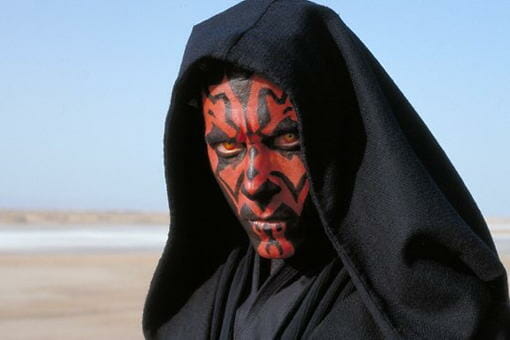By Tiffiny Whitney · February 13, 2012

If you’ve never seen Star Wars, you’ve been living under a rock and you should see it, starting with A New Hope, technically the chronological fourth episode in the saga, and then go back to the “prequels” (Episodes I-III). If you’re one of those “I have see it from the beginning” type of people though, then this is the best opportunity you’ll have in the magic of seeing a movie in a theatrical environment. Though your die-hard Star Warsfan is likely to disavow all knowledge of the prequels; Episode I was not the worst. It wasn’t on par with the original trilogy starting with A New Hopein 1977, but is still an acceptable “lead in” to the tragic hero’s story of Anakin Skywalker’s transformation into Darth Vader, and the formation of the evil Empire.
Star Wars: Episode I – The Phantom Menacebegins with the iconic crawl of bright, yellow text of exposition of the current story of the film. Essentially, there’s some big trade dispute, and smack dab in the middle of the evil Galactic Trade Federation’s plan to secure trading contracts and lots of moolah is the peaceful planet of Naboo. Initiating an illegal occupation of the planet, the protectors of the Republic, an awesome force of Zen-ish soldiers known as the Jedi, send Qui-Gon Jinn (Liam Neeson) and Obi-Wan Kenobi (Ewan McGregor) to explore the situation. Surprise, surprise—they end up getting dragged into the conflict. With the help of the most annoying character in the history of cinema (a Naboo native known as a Gungan, named Jar Jar Binks), the endangered planet’s queen, Amidala (Natalie Portman), and a young boy named Anakin (Jake Lloyd) that they befriend when their ship is marooned on the desert planet of Tatooine, the Jedi concoct a plan to take back the planet and stop the Trade Federation’s plans for occupation.
There’s actually a lot more layers to Phantom Menace than I initially noticed when I saw the film’s first theatrical release back in 1999, and it was these layers that kept me a bit more interested in the film from an intellectual standpoint than I initially was. And rule-wise, with as much crap that Lucas gets over the script, it was actually structured pretty well. There was a problem—the occupation of Naboo by the Trade Federation—and continued rising action throughout without more arising problems, culminating in a large conflict (battle) that eventually leads to a resolution and a lead-in to the next film. That being said, the political strife and intellectual struggle on that level was almost more interesting for me to watch and explore than the action sequences. Maybe that part would be boring to kids—but not to me.
Additionally, while each character in the film was their “own” person, the problem with the characterization in Phantom Menace was a little thin. Like the “originals” (Episodes IV-VI), each character is more an archetype that symbolizes something than a person we are supposed to be attached to. In the original films, I feel that you actually did attach to the characters in a very deep and relatable way. In Phantom Menace, the disconnect from the characters also makes the film feel longer and not as “whole.” The film watches like a 2-hour documentary on the fall of the Republic with multiple characters who play a role, but none of which get their own real “story.” In Episode I, the story should be Anakin’s because of the large part he plays across the entire saga. Instead, we don’t meet Anakin until about halfway in, don’t build any real connection with him, and don’t build any real connection to anyone else.
Finally, while I am generally not a fan of 3-D reformatting in movies, of all the films that could go back and be re-formatted, however, Star Wars is a cool one for a few reasons. Mostly the scenery is the reason I would go to see this film in 3-D, but pretty much for nothing else. Breathtaking even for the era it was created, 3-D only adds and almost makes it entirely worth the price of admission to see this film. The scenery, for me at least, is the only real place where 3-D really adds though. And also, maybe in the final, fateful lightsaber fight between Qui-Gon, Obi-Wan, and the insidious Darth Maul. Other than that, however, the 3-D was unnecessary and a gimmicky ploy by 21st Century Fox and George Lucas to make more money. Honestly, the theatrical release probably would have made the same amount in 2-D just from a new generation of younger Star Wars fans alone willing overlook the prequels’ serious pitfalls. The rest of the time, however, I felt the 3-D was distracting from the story, and completely not worth the extra $2.
Though there are die-hards out there who hate Phantom Menace with a vengeance, the re-release presents a wonderful opportunity for Star Wars fans to revisit the (ill-conceived) origins of the universe, and an even better opportunity for those who have never seen the saga to “start at the beginning.” Trying to stay objective and backing off from the original Episodes IV-VI, Episode I isn’t that bad of a movie, honestly—but it isn’t that great either. It reads like a history-meets-cinema textbook, and fails to really draw audiences in with a solid character with whom they can attach to and relate with to carry them through the next two films in the series. That being said—it’s, for some reason, not as bad as it was in 1999. And if you don’t mind lining Mr. Lucas’s pockets anymore than they already are, it’s not a bad way to spend a Saturday afternoon either.